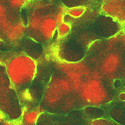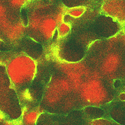A scaffold for soft matter
Several years ago, Michael Cates’ group at the University of Edinburgh, UK, predicted that the interfaces between liquids could act as loci for colloidal particles to aggregate and solidify during liquid-liquid phase separation [1]. Now, writing in Physical Review Letters, Cates and his group, including Eduardo Sanz, Kathryn White, and Paul Clegg, investigate what is necessary to keep the colloidal particles from redissolving, even after the liquids remix.
The scaffold for the colloidal particles ( spheres of silica) is a binary mixture of water and , -lutidine. When the liquid is warm, it phase separates into lutidine-rich and lutidine-poor regions, and the particles, which have an equal affinity for both liquids, move toward the interfaces between these two regions. Over time, the particles jam together to form a glassy state that is locally layered, but stretches throughout the volume of the liquid.
In principle, this way of templating colloidal structures could be useful within volumes that only fluids could reach, but what happens if the liquid scaffold is removed? The Edinburgh group finds experimentally that if the colloidal gel is allowed to age for some time after it forms, it will last even after the liquid is cooled and remixes into a single phase. They predict with simulations that a combination of short-range attractive and long-range repulsive interactions between the particles can lock the gel’s structure. Their findings open the possibility of being able to shape and reshape a templated colloidal structure, which may have applications in tissue scaffolding or drug delivery, with thermal cycling alone. – Jessica Thomas
[1] K. Stratford et al., Science 309, 5744 (2005).





